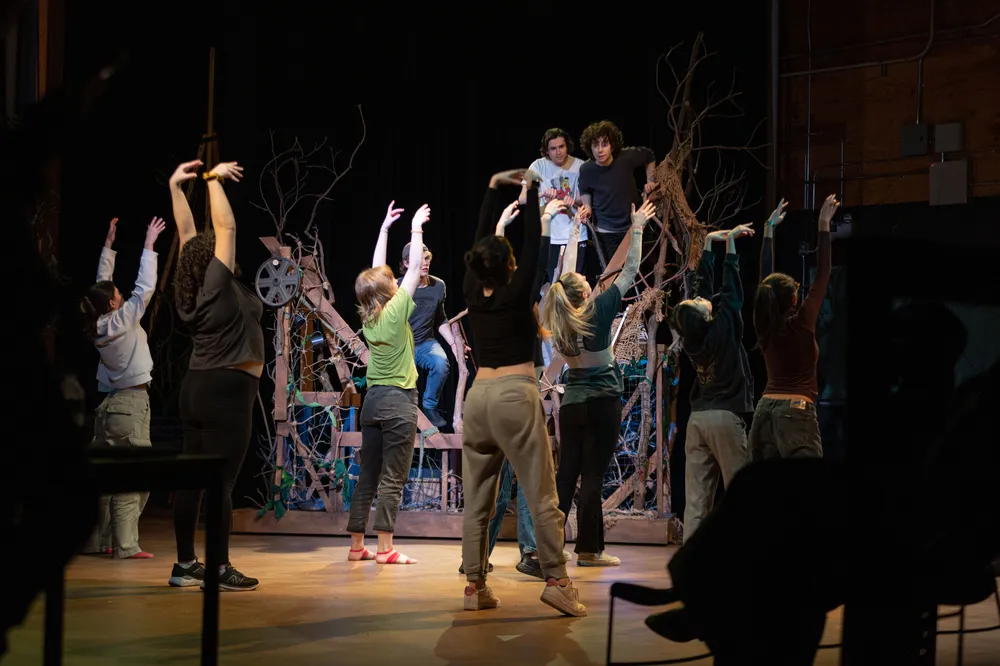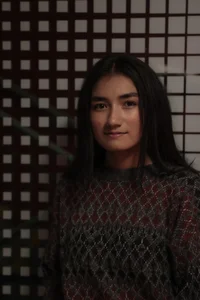With voices still buzzing and the house lights still shining, an actor in a white dress walks into the centre of the Dorothy Somerset Studio. She is solemn, stern and unsmiling. Her movements do not seem human. As more audience members begin to notice, they turn and watch her move slowly towards a wooden structure. She sits, laces rope around her fingers, then picks up two model birds.
Once again, as abruptly as she arrived, she is still.
Conversations continue, but the energy has shifted. It’s hard to ignore the figure in the corner, even as attendees continue to file into their seats. It sets the tone for the rest of Yvette Nolan’s The Birds, performed by UBC theatre students — tense, but with something beautiful about the discomfort.
The venue is a black-box theatre that only seats 55, which has never hosted a main-stage performance before this production. It’s a bit rough around the edges, but that fits right in with the unconventional nature of the play.
Based on Aristophanes’ comedy of the same name, The Birds follows Jack (Christian Billet) and Gulliver (Simon Auclair-Troughton), men who are desperate to escape their lives in the city which is plagued by capitalism and climate catastrophe. They find the home of the birds; a serene place still untouched by humans, excluding Hoopoe (Nico Pante), a human-turned-bird that has forced several of the birds into giving him authority.
Upon arrival in the land of the birds, Jack sizes up the territory, fantasizing about using the abundant space and resources to build a new city — despite that being the very thing he sought to escape in the first place. Gulliver, on the other hand, is more willing to listen to what the birds have to say, and even learns to live according to their customs and values.
The play follows the men as they navigate their relationships with the birds, realizing that their arrival may pose grave consequences for the community.
The cast has been rehearsing this piece since the fall, which has given them the opportunity to do a deep dive into research on the natural world, guided by director Michelle Olson. Even while doing synchronized dance, each actor carefully chooses gestures, facial expressions and noises that clearly differentiate each type of bird from another, from the poised Heron (Talia Peck), to the curious Yellow Warbler (Julia Eckert).
Though the actors take advantage of the opportunity to be playful, they also balance comedic quirks of the script with devastating representations of the darker elements of this story.
Rachel Angco, a third-year student in the Bachelor's of Fine Art + Master's of Management program, plays Nightingale, a storyteller who communicates through songs, which were composed by Angco herself.
In her song, Nightingale exposes ugly truths about her husband Hoopoe, who contributed to the “underlying traumatic and disturbing oppression of many people in [the birds’] world.”
“It’s been something that has taken a lot of conscious effort to navigate, because as an actor, it’s important to keep ourselves safe while portraying these really traumatic stories… I think there’s a lot of deriving from personal experiences, but at the same time, giving a voice to Nightingale’s story,” Angco said.
Along with the Nightingale’s story’s themes of sexual violence present is the clear depiction of the effects of colonialism on Indigenous communities, shown through Jack and Gulliver’s attempt to redevelop the birds’ territory into a bustling metropolis.
“I think that there’s this natural behaviour to navigate discomfort [through] comedy,” said Angco. “I don’t mean that in a way where the comedy takes away from the value or relevance or importance of an issue. Sometimes that light doorway into those conversations makes [them] more accessible to a wider range of people.”
The Birds took flight on March 16, with performances until March 25. Tickets are available through the theatre and film department’s website.
This article was corrected on March 19 at 9:23 p.m. to amend the name of Nightingale's song. The Ubyssey regrets this error.
Share this article
First online







